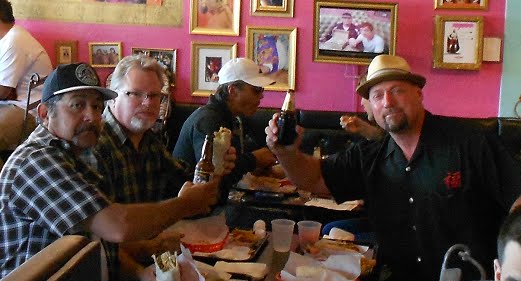If you should ever find yourself driving along Interstate 80 in the middle of Iowa and are in need of a diversion, may I suggest following the directions given on a series of signs advertising a genuine Danish windmill in the genuine Danish village of Elk Horn.
 The few residential streets are lined with multi-story stick-framed homes. White-picket fences optional.
The few residential streets are lined with multi-story stick-framed homes. White-picket fences optional. Being a Danish community, there is a very well-kept Lutheran church in the middle of town.
Like most small towns in the heartland of the United States, Elk Horn features a prominent monument to the men and women from the area who served the country.
What sets Elk Horn apart from every other small town on the Prairie is a genuine full-size Danish windmill, similar to the one in Solvang, Ca. Except this one has a grain elevator and silos behind it.
This much smaller windmill looks like the model used by miniature golf courses all over the country.
There is much more to see in Elk Horn than windmills, of course, such as the Danish History and Cultural museum in the north end of the town.
Just keep driving along the main street and at the intersection featuring rust-covered antiquated farm machinery, turn to the left.
The museum is housed in a building that reflects Danish architectural influences, and is being expanded. The large concrete foundation walls on the left will be the site of the addition, due to be completed by Summer 2015.
Immediately south of the museum is a walking path that leads to what appears to be a unique modern sculpture garden. But it's not - It's unique modern outdoor exercise equipment!
One of the first exhibits seen upon walking into the museum is dedicated to Denmark's largest export, Legos. There are a few examples of objects that can be built with the wonderful blocks, and at a table alongside those are a few thousand of the blocks for kids to build with.
As the museum is currently expanding, a large number of the exhibits have been put under protective wraps (the construction rattles the building a little). Still, there are a few displays kept in secure file drawers that showcase the crafts and interests of the Danish immigrants and their descendants.
One drawer features handcrafted pipes covered with intricate designs, something far more involved than the simplicity of line and reverence for functionalism that is usually associated with Danish craftsmanship.
Even with the museum in a state of flux, there are still some gems to be found - this sculpture was sitting (literally) behind glass in the conservator's room. It is titled "Seated Woman With Bird" but unfortunately I cannot read the name of the sculptor - too much distortion caused by the glass.
There is much about the history of Denmark, especially the Danish/German conflicts and other factors that contributed to the immigration of hundreds of thousands of Danes to the United States.
This Memorial Day weekend, the 24th and 25th of May, the villages will be celebrating the 34th annual Tivoli Fest, which will feature traditional Danish foods, a parade, folk dances, music and, well, all things Danish - even a Tour de Tivoli!

















No comments:
Post a Comment